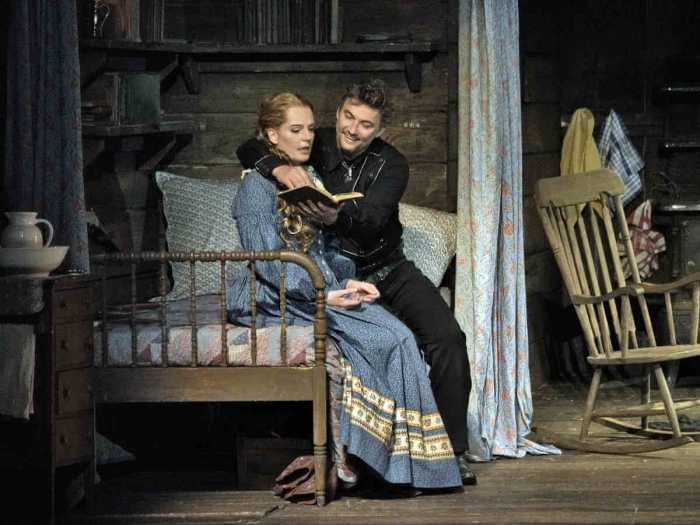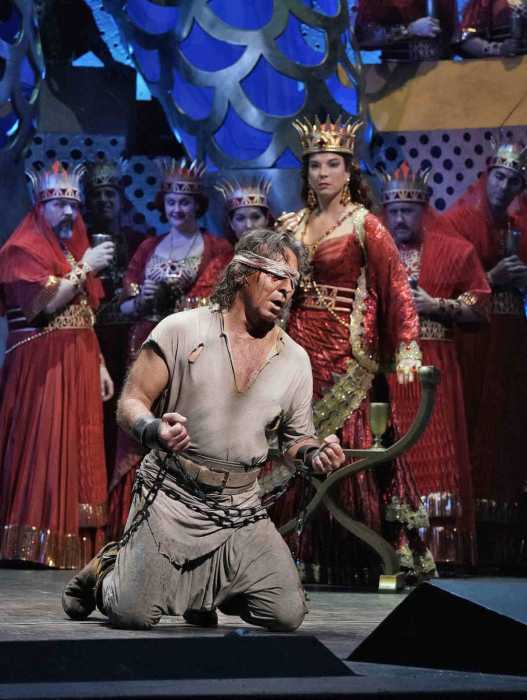Natalie Dessay as Cleopatra in Handel's “Giulio Cesare.” | MARTY SOHL/ METROPOLITAN OPERA
The Metropolitan Opera presented its first ever Handel opera, “Rinaldo,” in 1983. Five years later, it got around to his most popular opera, “Giulio Cesare,” in a John Copley production that originated at the English National Opera. This April, the Met unveiled its second production of “Giulio Cesare” — also a British import — the David McVicar “Bollywood” spectacular that premiered in Glyndebourne in 2005.
This production uses a much fuller musical text, restoring arias for Cornelia, Nireno, and Achilla previously excised and including all da capo repeats. Indeed, the evening stretched to four and half hours. McVicar sees Handel opera seria as pure entertainment. Each da capo aria was treated as a kind of floorshow with its own distinctive choreography, stage business and props, performing supernumeraries, and sight gags.
Met returns to Handel, with McVicar production of “Giulio Cesare”
McVicar equates Caesar’s Roman conquest of Egypt with Britain’s colonization of India. Caesar and his soldiers were in British Army uniforms circa 1912, and Cornelia and Sesto were dressed from the same era. Cleopatra time traveled from harem girl outfits to jazz age flapper gowns to Art Deco ‘30s Hollywood starlet style to full 18th century fig in the last scene. The set, enlarged from the Glyndebourne original, is a Baroque theater with receding proscenium arches opening up to a seascape vista. Silk draperies and flying scenery take us from the Roman camp to the palace of Alexandria.
The production highlights the libretto’s Shakespearean mixture of comedy and tragedy. The Egyptian characters are played for laughs — Ptolemy is a ridiculously vain popinjay, Nireno a dizzily effeminate old-school queen, and Cleopatra a calculating sex kitten. Meanwhile the Cornelia/ Sesto subplot is played for high drama —both are subjected to realistic physical abuse and, in Cornelia’s case, near rape by their Egyptian captors. Caesar ranged from a fool for love to a man of purpose. Cleopatra developed tragic stature in later scenes when she faced defeat. Supers dressed as native servants expressed dismay at their country’s submission to a foreign power at the final curtain.
McVicar’s hyperactive staging with its Bollywood dancing, self-conscious artifice, and camp flourishes often distances the viewer from any true emotional empathy. However, for an audience not versed in Baroque opera, this was a highly diverting, if long evening of musical theater.
The Met replaced the original star of the Glyndebourne production, the multi-talented Danielle de Niese, with Natalie Dessay as Cleopatra. Countertenor David Daniels was Caesar. Both Dessay and Daniels have seen better days vocally. After an opening night reported to be uneven, Dessay canceled the second show on April 9. In a “surprise” appearance, de Niese, who according to Peter Gelb’s onstage announcement “just happened to be traveling to New York with her husband,” replaced Dessay on only a day’s notice with minimal rehearsal. Reliable sources, however, inform us that, weeks before, de Niese had been summoned by Gelb to stand by for the unreliable Dessay and rehearsed in private. The day after de Niese appeared, Gelb’s publicity machine spun into action with New York Times blurbs about her heroic “impromptu” substitution. Still, Dessay returned for all subsequent performances including the HD transmission.
After seeing the de Niesse performance, I returned to the production on May 7 to hear Dessay, and the comparisons were striking. The duskily beautiful, dance-trained de Niese shimmied and vamped with natural ease while the quirkier Dessay was more self-parodying. However, de Niese has the voice of a soubrette with a shallow timbre that turns tinny or brassy under pressure and lacks innate nobility in slow arias. She chirped prettily through lighter numbers like “Venere Bella” and “Tu la mia stella sei.” But in the long-lined sensuous “V’adoro, pupille,” the plainness and ordinariness of her timbre were evident. The charm was merely visual.
Dessay on May 7 surpassed her efforts on the HD transmission, where vocal fatigue and tonal fallout occasionally intruded. In person, she seemed vocally rejuvenated. Her silvery tone and aristocratic phrasing have an innate purity and nobility, and her coloratura has elegance and finish. Many phrases were spun like silken threads with a delicate precise touch in ornaments. Cleopatra’s final triumphant “Da tempeste” revealed Dessay performing ornate roulades while executing precision choreography with insouciant bravura. If this was her last Met engagement, as is rumored, Dessay has left on a high note.
Daniels’ turn as Caesar also improved as the run progressed. He is better at broad lyrical cantilena than martial dramatic coloratura. His runs were smudgy in Caesar’s bravura arias, with the voice losing core and dropping out lower down. This is an area where a mezzo or contralto has more tonal resonance and “balls” than a countertenor. Daniels, though, remains an authoritative stylist and stage performer.
Countertenor Christophe Dumaux as Tolomeo showed a remarkable command of his instrument and the stage — he sang with unfailing energy and purity, modeled outrageous costumes, and performed acrobatic falls and leaps with ease. Patricia Bardon’s Cornelia had some stiffness in the upper register and graininess below, but she is a stylish Handelian and a committed actress. Her intensity was matched by Alice Coote’s tortured Sesto — here almost a Hamlet figure. Coote’s dramatic delivery suited the fast vengeance arias better than the lyrical largos.
Moroccan countertenor Rachid Ben Abdeslam camped imperiously as Nireno, but his tone and diction were mushy and indistinct. Bass-baritone Guido Loconsolo’s hairy, sexy Achilla was more effective in recitatives than in his arias — the native Italian diction didn’t compensate for a fuzzy grumbling timbre.
Harry Bicket is emerging as the Met’s number one conductor of pre-Romantic opera — he made the Met orchestra sound like a historical instruments ensemble. He appreciates how each aria has its own unique musico-dramatic color and how the musical contrasts in each succeeding number build drama. Four and a half hours flew by as one visual and musical delight followed another.



































